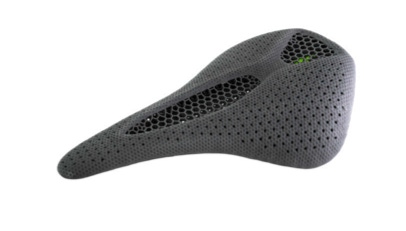Bike saddle printed on Carbon platform
With the Carbon platform, Specialized discovered a new way to address a pervasive challenge for riders and did so twice as fast as their normal development process.
September 27, 2019

For cyclists at all levels, one of the most important aspects of the riding experience is the bike saddle. Comfort is performance for riders, as discomfort is frequently cited as a reason for abandoning the sport. Specialized has addressed this with new products for over 20 years, ultimately reaching the practical limits of traditional manufacturing methods with different types of foam.
|
Example of a pressure map (above) and the bike saddle lattice configuration below), showing enhanced comfort zones optimized to distribute pressure and improve stability. |
|
In the latest development, Specialized was able to develop a bike saddle made from elastomeric lattices that perfectly matched riders’ requirements of lower peak pressure with a more gradual pressure distribution, and then fully scale it to production using the Carbon platform.
In addition, Carbon developed a new technique using excimer lamps to engineer a tailored, microscopic topography that gives the saddle the perfect amount of surface grip in a premium matte finish. This marks the first time this technique has been used in a commercialized, 3D-printed application. With the Carbon platform, Specialized was ultimately able to reduce production time from 24 months to 10 months: a record time to develop a new bike saddle.
Specialized’s previous leading bike saddle showed improvement through combining three types of foam that offered different amounts of stiffness for varying functional zones; however, there was no practical way for Specialized to add more zones.
Specialized needed to create a bike saddle that maximizes performance by simultaneously providing comfort and stability. However, the two major components that were missing were a material that would allow for the infinite variability of saddle density, and a production process to build ideal comfort zones
Elastomeric lattices featuring Carbon EPU resin from digital manufacturing company Carbon are reportedly well suited for this application as they combine tear strength, energy return, and elongation—making them perfect for cushioning, impact absorption, and vibration isolation.
But given the choice, would a rider prefer less impact or greater energy return? To answer this, Specialized used Carbon technology to test the same saddle design made with two different materials: one optimized for impact absorption and one for energy return.
While it intuitively seems like increased impact absorption would produce a smoother ride, in reality as the seat absorbed impact, it slowly compressed, ultimately decreasing comfort. Riders clearly preferred energy return to hold them in place.
Specialized theorized that while creating zones that compressed easily could improve comfort, riders still needed some amount of support and pressure to assist with stability and blood flow. The first design focused on this theory utilized soft, large pockets for the rider’s sit bones.
Testing showed that uniform softness caused instability, often associated with gel saddles, and reduced rider control. This was addressed with a compression gradient, pocketing the sit bones in a soft center and steadily increasing the stiffness throughout the Specialized teardrop zones. The result was the perfect combination: a bike saddle that optimally distributes pressure to increase comfort while giving the rider the control they need to perform at their best.
About the Author(s)
You May Also Like






